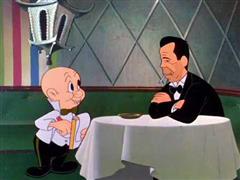The idea of the fourth wall is commonly thought to have originated with the French philosopher Denis Diderot, though he didn’t give it a number. Diderot wrote in 1758: “When you write or act, think no more of the audience than if it had never existed. Imagine a huge wall across the front of the stage, separating you from the audience, and behave exactly as if the curtain had never risen.”
Today, when the fourth wall is invoked, it’s usually in reference to “breaking” it — that is, writers or characters who disobey Diderot, acknowledge the audience’s existence, and directly speak to it. And it’s invoked a lot, as we live in a very meta age, where art both high (Milan Kundera’s The Unbearable Lighness of Being) and low (virtually every episode of Family Guy) are concerned.
Even before it had a name, fourth-wall-breaking had a long history — Chaucer and Shakespeare do it, to name two luminaries — but in the middle decades of the twentieth century, it had a very special province in American comedy (plus Monty Python). Early on, it served anarchic, transgressive ends, for example in Marx Brothers movies. As Arts & Popular Culture describes, “In their 1932 film Horse Feathers … when Chico sits down at a piano to begin a musical interlude, Groucho turns to the camera and deadpans ‘I’ve got to stay here, but there’s no reason why you folks shouldn’t go out into the lobby until this thing blows over.'”
In the truly weird Never Give a Sucker an Even Break (1942), W.C. Fields, playing himself, unsuccessfully tries to sell a script to a movie executive named Mr. Pangborn, played by Franklin Pangborn. He goes to an ice cream parlor to drown his sorrows and talks directly to the camera: “This scene is supposed to be in a saloon, but the censor cut it out.” And Warner Brothers cartoons are full of moments when Bugs Bunny and other characters make wisecracks intended solely for us, the audience.
The fourth wall got pretty much obliterated in the television series The George Burns and Gracie Allen Show. In the early years of its 1950-’58 run, when it was filmed live, Burns (playing comedian George Burns) would stand to the side and comment to the audience about the action. Through 1953, Fred Clark played the part of Harry Morton. In an espisode that year, Wikipedia says:
George walks on-stage and freezes the scene just before Harry’s entrance and explains that Clark has left the show to perform on Broadway. He introduces Larry Keating, who enters, and then calls over Bea Benaderet to introduce the two saying, “This is Larry Keating and he is going to be your husband now”. The pair greet and chat briefly, complimenting each other on their previous work. George remarks that if they are going to be so nice to each other, no one will believe they are married. Burns then gives a cue, Blanche resumes her position, and the scene continues where it stopped as if nothing had happened.
In the later years of the series, in a rather eerie Big Brother move, George would repair to his study and spy on the other characters on a TV screen.
The insult-the-wife’s-cooking humor hasn’t aged well. (By the way, that’s Larry Keating as Harry.) Later in the scene, George switches to another channel in an effort to locate his wife, Gracie.
Part of the humor is that the audience knew — or at least knew the shtick — that Benny was a cheapskate, and that he and Burns were buddies.
This sort of insider knowledge — more comfortable than Marxian comic iconoclasm — is the basis for a lot of the many instances of wall-breaking in the seven “Road” movies Bob Hope, Bing Crosby, and Dorothy Lamour made between 1940 and 1962. One or the other of the boys is constantly looking at the camera and joking about Crosby’s golf playing, Hope’s inability to win an Oscar, and the studio that produced all but one of the pictures, Paramount. Arts & Popular culture notes:
In Road to Utopia, they are traveling across frozen land on dogsled, when a mountain appears. Hope says, “Get a load of that bread and butter!” Crosby remarks, “Bread and butter? That’s a mountain!” Then the words “Paramount Pictures” appear on the mountain and Hope comments, “It may be a mountain to you, but it’s bread and butter to me!”
In Road to Bali (1952), directed by Hal Walker, as some music starts to play, Hope looks at the camera and says, “He’s gonna sing, folks. Now’s the time to go out and get the popcorn.” Later, the trio are shipwrecked on a desert island when all of a sudden a guy in white-hunter outfit and pith helmet strolls in, raises a shotgun, fires it, and walks away. Crosby remarks, “That’s my brother Bob. I promised him a shot in my next picture.” Then,
It’s actually a clip from Bogart in The African Queen, which won the Best Picture Academy Award the previous year. Bogie clearly was a good sport, allowing his image to appear not only here but in the Bugs Bunny classic Slick Hare (1947).

